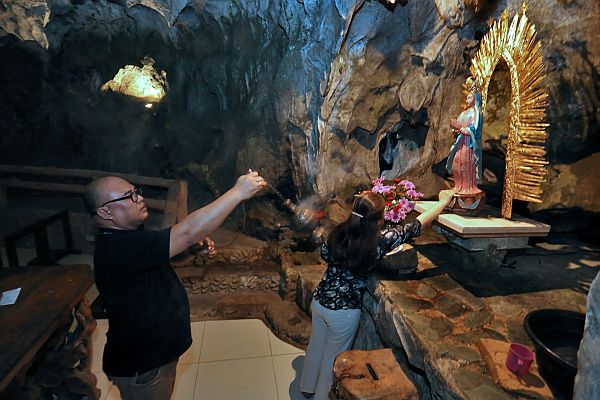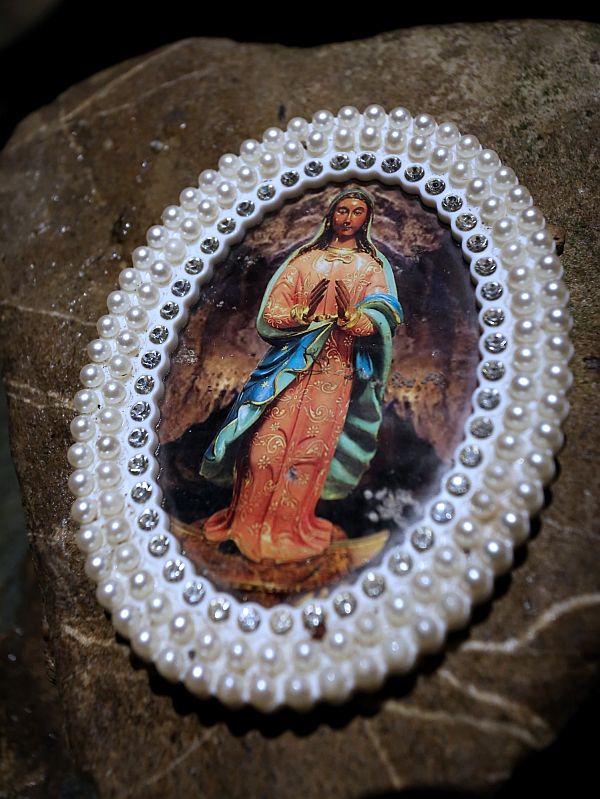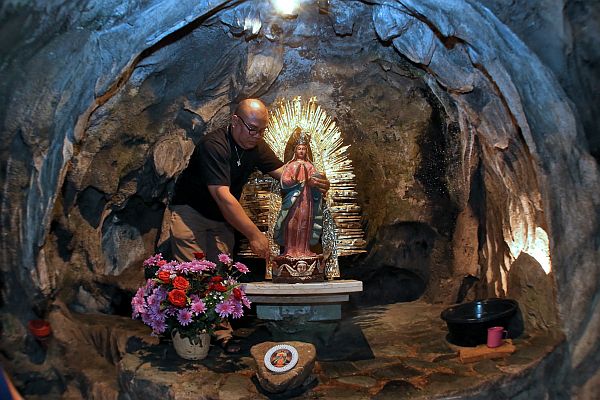Our Lady of Guadalupe’s Langob Shrine: A cave to calm the heart, heal the soul

The image of Our Lady of Guadalupe in “Langob Shrine” barangay Kalunasan.(CDN PHOTO/JUNJIE MENDOZA)
Amid Cebu City’s fast-paced lifestyle, one would never imagine there is still a place so close to the urban center that allows one to commune with nature. Until you get to this cave in the heart of Barangay Kalunasan.
Nestled in the hills of the Queen City of the South, the Guadalupe Cave or commonly known as the Langob Shrine has been open to render a welcoming retreat to visitors.
Although a serene oasis amid the hustle and bustle of the metropolis, the underground chamber has been overlooked, prompting priests taking care of the shrine to rekindle the people’s interest in the place that is so much a part of Cebu’s history and faith.
“People know that this cave exists, yet it seems that it has slowly been forgotten,” said Fr. Romeo “Dodong” Desuyo of the Archdiocesan Shrine of Our Lady of Guadalupe de Cebu.

The image of Our Lady of Guadalupe in “Langob Shrine” barangay Kalunasan.(CDN PHOTO/JUNJIE MENDOZA)
Repair works are currently being done to preserve and improve Langub Shrine, where a wild-chicken hunter discovered the image of the Blessed Virgin Mary in the early 18th century.
A replica of the original image enthroned inside the cave was recently stripped of its outer garments to closely resemble the actual features of the Marian icon at the time it was found.
“The image was carved (by a native), (and) it is beautiful. Now, people can see how it really looked like years ago,” said Desuyo, a heritage enthusiast and collector of various religious images.
Close to the two-foot image is water dripping from stalactites — a tapering structure that naturally adorns the cave illuminated by a few light bulbs on the sides and the main altar.
Some devotees to the shrine come to get and drink the water, which they believe to be miraculous. Basins of water from the cave are also brought to the main church in Guadalupe and boiled before it is placed in bottles for the sick to drink.
“Actually, it’s not the water that heals but our faith,” Desuyo stressed.

Fr.Romeo Desuyo stand before the image of Our Lady of Guadalupe in “Langob Shrine” barangay Kalunasan.(CDN PHOTO/JUNJIE MENDOZA)
Image, beloved
According to locals, the cave in Kalunasan, which was then part of Sitio Banawan (now Barangay Guadalupe), began to draw people after the image of the Blessed Virgin Mary was found on a naturally formed rock, beside which a slow drip of water cascaded into a basin-shaped rock on the floor.
On this site, a hermitage, made of light materials, was built but was later burned down. For this reason, the image of was brought to the church of San Nicolas which, at that time, had jurisdiction over the place.
Sometime in May 1902, a cholera epidemic hit Cebu. According to historical archives, the epidemic was so devastating that hundreds of residents died. The outbreak was so bad that those who buried the dead did not return as they themselves died along the way or right in the cemetery while grieving for their dead relatives.

Fr.Romeo Desuyo blesses the image of Our Lady of Guadalupe in “Langob Shrine” barangay Kalunasan.(CDN PHOTO/JUNJIE MENDOZA)
The natives sought the intercession of the Our Lady of Guadalupe de Cebu and brought the image for a series of dawn processions from mid-May to mid-June. The number of deaths dwindled until it eventually ceased.
As an act of thanksgiving, a Mass is celebrated in honor of the Blessed Mother every July 16.
The parish priest of San Nicolas earlier gave his permission for the construction of a small chapel in honor of Our Lady of Guadalupe in Kalunasan and agreed to lend them the Marian image for the annual fiesta celebration with the promise that it should be returned to the mother church after the feast.
This ritual went on until the 1920s when the icon, while it was brought back to San Nicolas on an andas or wooden carriage, suddenly fell on the ground upright. It remained standing and made a 180 degree turn by itself, facing the direction of the chapel where she came from.
When the parish priest of San Nicolas learned about the incident, he decided that the image be permanently enshrined in Guadalupe.
Although the original image of the Our Lady of Guadalupe de Cebu was later enthroned in a larger church, a replica remains at the cave where it was found.

The image of Our Lady of Guadalupe in “Langob Shrine” barangay Kalunasan.(CDN PHOTO/JUNJIE MENDOZA)
Carved locally
Desuyo explained that the Marian image was locally made, contrary to earlier claims that it was among the icons brought by Portuguese explorer Ferdinand Magellan to the island in 1521.
He said the image is a prototype of the Immaculate Conception with hands joined in prayer, a crescent moon at its feet, and three cherubs representing the theological virtues of faith, hope and love.
When Magellan set foot on Cebuano shores, he said, there was no Our Lady of Guadalupe yet because it was only in 1531 or 10 years after the Portuguese explorer arrived in Cebu that the Blessed Virgin Mary appeared to Juan Diego in Mexico.
If there are images of the Blessed Mother under the same title — the Guadalupe de Extremadura and Guadalupe de Somera — they are carrying the child Jesus.
“Perhaps, the priest in San Nicolas Parish called the image the Our Lady of Guadalupe because it resembles the Guadalupe de Mexico,” Desuyo explained.
“But the image we now venerate as the Our Lady of Guadalupe de Cebu is a prototype of the Immaculate Conception,” he added.
Another sign that the image was done by a Filipino is the suksok at the back of the image, a distinct feature of Filipino sculptural rendition of the
Blessed Virgin Mary as a “Grand Filipina” with a long skirt that needed to be tucked at the back of the waist.
Desuyo said the image of the Our Lady Guadalupe de Cebu was carved from tugas or molave, a hardwood found in tropical countries such as the Philippines.
And if the Marian image is used to accompany the Sto. Niño de Cebu during the annual Traslacion and fluvial processions every January, the priest said it is not to symbolize Magellan’s baptismal gift but its being the principal patroness of the entire island of Cebu as declared by Archbishop Emeritus Ricardo Cardinal Vidal in 2002.
The original image of the Our Lady of Guadalupe de Cebu is enthroned at the main altar of the Guadalupe Church, while a replica is venerated at the cave.
“Our devotion did not come from Mexico nor the image from Spain. We are proud enough that we have our own Guadalupe de Cebu,” Desuyo said.
“Go to Mary”

Fr.Romeo Desuyo fixes the image of Our Lady of Guadalupe in “Langob Shrine” barangay Kalunasan.(CDN PHOTO/JUNJIE MENDOZA)
The Guadalupe Cave currently has two Masses every Saturdays and Sundays at 9:30 a.m. and 4 p.m.
A Healing Mass is also held at the cave every first Saturday of the month at 9:30 a.m.
“We encourage people to visit our Lady at her cave as we try to propagate further the devotion to Cebu’s patroness,” Desuyo said.
Amid life’s struggles and pain, he urged the people to go to Mary and seek her intercession.
“Mary has played a significant role because without her, salvation could have been dim. She is the most beautiful flower in God’s paradise. And so we honor her as the mother of Jesus and of humanity,” the priest said.
Desuyo said the message of the Blessed Virgin Mary, as in her previous apparitions, continues to reverberate throughout the world: prayer, unity and peace.
“Our country is fragmented. We are not united as a people and even as Christians. What we need now is peace. Let us pray to Our Lady for peace and unity,” he said.
Disclaimer: The comments uploaded on this site do not necessarily represent or reflect the views of management and owner of Cebudailynews. We reserve the right to exclude comments that we deem to be inconsistent with our editorial standards.
